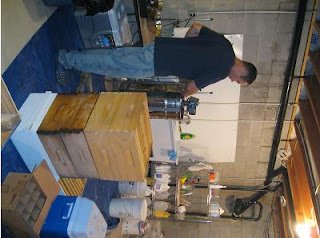Overall, the extraction process took 2 days, but I'm sure it will be about 2 weeks until we uncover every last sticky doorknob and droplet of honey that managed to escape the tarp. Here is Rog's mini-photo-journal of the process:
OK, no matter how many times I edit and re-save these photos, I cannot for the life of me get them to stay vertical. Tip your head to the right for the full effect. . .
 |
| Rog has officially taken over my milk processing corner in the basement. Not one rogue bee managed to make it into the house. . . yet |
 |
| Three similar weighted trays are selected first. A heated knife is used to un-cap the honeycomb before placing it into the extractor. |
We do not pasteurize or process the honey in any way. We do store bottles and combs in the freezer to help delay the crystallization process, which is common with raw honey. Raw honey will last for years if properly stored. Crystallized honey can be gently heated and will be restored to its liquid state.
Raw honey has a few medicinal properties as well. It contains amylase, which occurs naturally in the pollen of many flowers, and helps the body to digest starchy carbohydrates. Raw honey is also gaining popularity as a homeopathic cure for seasonal allergies. It contains residual amounts of plant pollens and molds that, when ingested in small manageable doses, can boost the immune response and eliminate the histamine induced allergic responses to these plants. To get maximal benefits, you have to buy local- ideally within 5 miles of your home.
Info about available honey, ie, sizes, prices will post soon. . .
"No bees, no honey, no work, no money..." Unknown
“You don't have to have a professor's dome Not to go for the honey when the bee's at home” Unknown
“The pedigree of honey Does not concern the bee; A clover, any time, to him Is aristocracy.”
Emily Dickinson
Emily Dickinson
“The careful insect 'midst his works I view, Now from the flowers exhaust the fragrant dew, With golden treasures load his little thighs, And steer his distant journey through the skies.” John Gay






No comments:
Post a Comment